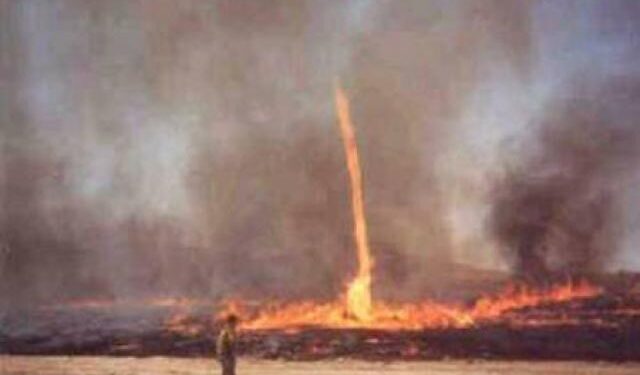A rare and dramatic fire tornado was captured swirling through the dense smoke of a raging wildfire in Portugal, spotlighting the escalating intensity of the country’s wildfire season. The phenomenon, officially known as a fire whirl, formed amid fierce flames and turbulent winds, underscoring the challenges faced by firefighters battling blazes across the region. Authorities reported the wildfire continues to threaten communities and natural landscapes as emergency teams work to contain the fast-moving inferno.
Fire Tornado Forms Amid Portugal Wildfire Threatening Communities
Amidst an escalating firefighting effort in Portugal, an extraordinary and terrifying natural phenomenon unfolded as a fire tornado spiraled upward through thick smoke clouds. These rare pyrocumulus-driven whirlwinds, fueled by intense heat and turbulent winds, pose an additional threat to both firefighters and residents attempting to escape the rapidly spreading wildfire. Witnesses described the swirling vortex as a “whirling inferno,” with flames licking the sky and sending embers hurtling in unpredictable directions, complicating containment strategies across several affected municipalities.
Authorities remain on high alert as the wildfire’s behavior grows increasingly erratic, driven by dry conditions and gusty winds. Emergency response teams have prioritized evacuations from high-risk zones and mobilized aerial water bombers to minimize the spread. Key concerns include:
- Sudden shifts in wind direction exacerbating fire movement
- Potential for additional fire tornado formation
- Threats to critical infrastructure and residential areas
| Area | Evacuations Ordered | Firefighting Units Deployed |
|---|---|---|
| Leiria | 5,000+ | 15 |
| Coimbra | 3,200 | 10 |
| Castelo Branco | 4,000+ | 12 |
Meteorological Conditions Fueling Firefighting Challenges in the Region
Unprecedented shifts in weather patterns have dramatically intensified the conditions firefighters face on the ground. The presence of highly unstable air masses combined with escalating temperatures has created a volatile environment where fire behavior becomes erratic and unpredictable. Gusts reaching over 40 km/h carry embers miles ahead of the main blaze, igniting spot fires that rapidly spread through dry vegetation. These fierce winds, alongside plummeting humidity levels, contribute to a relentless push of the infernos, straining suppression efforts to their limits.
Adding complexity, the formation of pyrocumulus clouds – thick, smoke-filled thunderclouds generated by the heat of the fires – further complicates aerial firefighting operations. These clouds often spawn erratic downdrafts and localized winds, feeding the flames and sometimes resulting in fire tornadoes, as witnessed in recent events. Below is a summary table outlining key meteorological factors currently impacting firefighting strategies:
| Condition | Impact on Firefighting |
|---|---|
| Wind Speed & Direction | Spreads embers; changes fire front rapidly |
| Temperature Extremes | Dry fuels ignite more easily, intensify flames |
| Low Humidity | Dries vegetation, increasing flammability |
| Pyrocumulus Formation | Generates unpredictable winds; hinders air support |
- Erratic fire behavior demands constant adaptation of tactics.
- Rapid weather changes reduce operational windows for aircraft.
- Increased risk to personnel safety in unpredictable conditions.
Emergency Response Strategies and Evacuation Plans for At-Risk Residents
Communities vulnerable to intense wildfire phenomena must prioritize swift and clear response mechanisms. Local authorities and emergency services have developed layered communication channels that include real-time alerts via mobile apps, SMS notifications, and community sirens to promptly inform residents of escalating fire dangers. Evacuation routes are rigorously planned and regularly updated to avoid bottlenecks, taking into account the unpredictable behavior of fire tornados and their rapidly shifting smoke plumes. Special attention is given to identifying safe zones that offer natural firebreaks and sufficient space for temporary shelters equipped with critical supplies such as water, first aid, and oxygen masks.
In addition, coordinated drills between fire brigades, medical teams, and community volunteers are essential to rehearse emergency protocols, emphasizing the rapid relocation of at-risk residents-especially the elderly, disabled, and families with young children. The table below summarizes core components essential for effective evacuation planning in wildfire-prone areas:
| Element | Description | Priority Level |
|---|---|---|
| Alert Systems | Multi-channel notification for immediate warnings | High |
| Evacuation Routes | Pre-mapped, clearly marked, and regularly reviewed roads | High |
| Safe Zones | Designated areas with protection from fire and smoke | Medium |
| Community Training | Regular drills and education for residents | Medium |
| Support Services | Medical and logistical aid during evacuation | High |
Final Thoughts
As firefighting efforts continue amid challenging conditions, the dramatic images of the fire tornado serve as a stark reminder of the wildfire’s intensity and the growing threat posed by such extreme weather phenomena. Officials remain focused on containment strategies while communities brace for ongoing impacts. Further updates will follow as the situation develops.
















